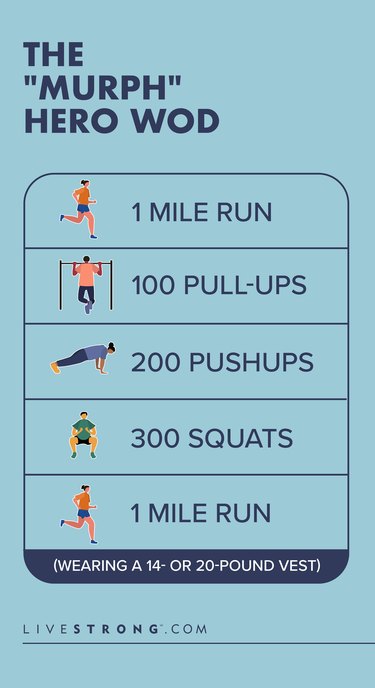

Every Memorial Day, hardcore CrossFitters, celebrities, exercise newbies and weekend warriors alike flock to CrossFit gyms (known as boxes) across the U.S. for one purpose: to tackle the Murph workout.
Murph is easily one of the most popular CrossFit routines. But its significance reaches far beyond its reputation as a grueling feat of fitness. Here's what it takes to do the workout — and why you should try it this year.
Video of the Day
Video of the Day
What's a Murph Workout?
- 1-mile run
- 100 pull-ups
- 200 push-ups
- 300 squats
- 1-mile run
Official guidelines state that this workout of the day (WOD) should be done wearing a 20-pound vest (you can modify with a 14-pound vest). But you can modify as needed, doing the WOD without a vest or modifying the exercises (though this wouldn't be permitted in a competition setting).
What Is a Murph Workout?
People who take on this CrossFit routine do a one-mile run, knock out a whopping 100 pull-ups, 200 push-ups and 300 squats, then round things out with another one-mile run. Per the organization's rules, you can wear a weighted vest that's either 20 or 14 pounds.
"It's definitely a tough workout," says Jenna Stankus, CSCS, a certified strength and conditioning specialist, CrossFit coach and owner of Hardwired Fitness in New York. Still, she says you won't hear anyone complain about doing the workout.
Why? Because the Murph is more than just a workout. It's a Hero WOD. These WODs are tributes to a fallen first responder or member of the military (more on that below).
Who Was Lt. Michael Murphy?
"[Hero WODs] are meant to be challenging in order to honor the sacrifice that these soldiers have made in defense of our freedom," says Alison Heilig, CPT, a CrossFit coach and author of The Durable Runner.
The Murph workout was named after Navy SEAL Lt. Michael P. Murphy, who was killed in action in Afghanistan in 2005, according to the U.S. Navy. After his death, he was awarded the Congressional Medal of Honor for his bravery.
The WOD Murph was a favorite workout of Lt. Murphy, although he called it Body Armor, per CrossFit. The story of Lt. Murphy (and the other members of SEAL Team 10) is told in Marcus Latrell's book Lone Survivor, as well as a movie by the same name.
Many CrossFit boxes and individuals even sign on to take part in the official Murph Challenge, an annual fundraiser hosted by Forged that benefits the Lt. Michael P. Murphy Scholarship Foundation. Started in 2007 by Lt. Murphy's parents and brother, the foundation now awards collegiate scholarships each year. To officially register for the challenge, go to TheMurphChallenge.com.
"It's exciting for people to be part of something bigger than just what's going on at their [CrossFit] box," Stankus says.
Related Reading
Who Can Do the Murph WOD?
The Murph is tough, yes, but you don't have to be super-fit or a seasoned CrossFitter to do it. "The idea of CrossFit is that everything is universally scalable," Stankus says. In other words, you can modify the workout however you need to make it doable for you.
Murph Challenge Rules
There are no strict rules behind the challenge. As mentioned above, you can modify different portions of the workout to suit your fitness level.
For example, if you want to try the Murph workout, but you're new to exercise, new to CrossFit or have movement limitations, you can always split the Murph workout in half. That equals a 800-meter run, 50 pull-ups, 100 push-ups, 150 squats and another 800-meter run.
You can also modify the exercises according to your comfort and fitness level:
One-Mile Run
You don't need to sprint the mile section — and probably shouldn't. Take the run at a pace that feels sustainable or alternate between walking and running, as needed.
How to Modify
If running is uncomfortable for you, substitute the run segments with an alternative form of cardio (ex. rowing, air bike, walking).
100 Pull-Ups
Most people can't do tons of consecutive pull-ups and that's totally okay. Instead, break this portion up into sustainable chunks. Do 10 pull-ups at a time, moving onto the other exercises in the meantime. Alternating between exercises can help you give your muscles a break, so you can finish the entire WOD.
How to Modify
Can’t do a pull-up? Wrap a long-loop band around the bar and plac your foot or knee in the free end for extra assistance. Or, jump up onto the bar and use momentum to help complete the motion., You can also swap out the exercise for inverted rows.
200 Push-Ups
As with your pull-ups, it's best to break these down into bite-sized chunks. Doing 10 to 20 reps at a time is more sustainable and can help you get through the workout more quickly.
How to Modify
You don't need to do perfect push-ups every set but you do want to practice good form to avoid injury. So, if you can't complete all your push-ups (or this exercise isn't available to you), drop down to your knees to modify the move. Or, place your hands on an elevated surface, like a bench or box.
300 Squats
For more experienced athletes, your endurance is the focus during this portion. In that case, bodyweight squats feel pretty comfortable but doing 30 to 40 at a time is still a cardiovascular challenge. So, pace yourself and remember to keep your form a priority.
How to Modify
Only squat as low as you feel comfortable and can keep proper squat form. You can make the move easier by shortening your range of motion, squatting down to a box or bench.
Beyond modifying exercises, reducing your reps and splitting the workout in half, there are different ways to attack the Murph workout. While you have to start and end the workout with the run (or alternate cardio), you can split up the pull-ups, push-ups and squats however you wish. It's also worth noting that you don't have to wear the weighted vest if you're not ready for it.
If you're hesitant to try the workout because you
don't think you'll be able to complete it as-written, know that most CrossFit coaches will work with you to ensure you have a safe and enjoyable experience. "We have people in their 60s who will come in and do this workout alongside teenage kids," Stankus says.
What's more, skipping the workout just because you can't do everything in it misses the point of doing the workout in the first place. "It's not about doing the workout as prescribed, it's more about coming in and being part of something bigger than yourself," Stankus says.
Warning
If you have a chronic health condition or other health concern, you'll want to work with your doctor and coach to determine if trying the Murph (even modified) is a good idea.
How to Prepare for the Murph Workout
Know Your Strategy
Both Heilig and Stankus agree it's critical to go into the Murph with a plan. During her first year, for example, Heilig initially tried to complete all reps of each Murph exercise before moving to the next. She managed to get through the pull-ups just fine, but found she hit a wall once she passed the halfway mark on the push-ups.
At that point, she decided to shift her strategy: "Instead of just wasting time staring at the floor, praying for another push-up, I would just start moving onto the squats," Heilig says.
Train With Cindy
Do the math and you'll discover that the Murph workout, aside from the workout, is the equivalent of doing 20 rounds of Cindy (another WOD that involves 5 pull-ups, 10 push-ups and 15 squats). "Then, on the floor, you're just making chalk marks to signify how many rounds you've done," Heilig says. In fact, practicing Cindy is a great way to prep for the Murph.
"You get this feeling of what it's like to flow through these movements, and though people don't hit 20 [rounds], at least you're mentally prepared," Heilig says. She also recommends trying the three Murph exercises (pull-ups, push-ups and squats) after a regular workout when you're already exhausted, "because you're going to be tired during Murph."
Pick one move to tack on to the end of your workout and see what it feels like (and how long it takes) to do 50 push-ups, 20 pull-ups or 100 squats. "Because that's the part of [the workout] that makes it so challenging — the volume of these movements," Heilig says. Start with a rep count that's challenging but doable and gradually increase reps as you feel able.
Related Reading